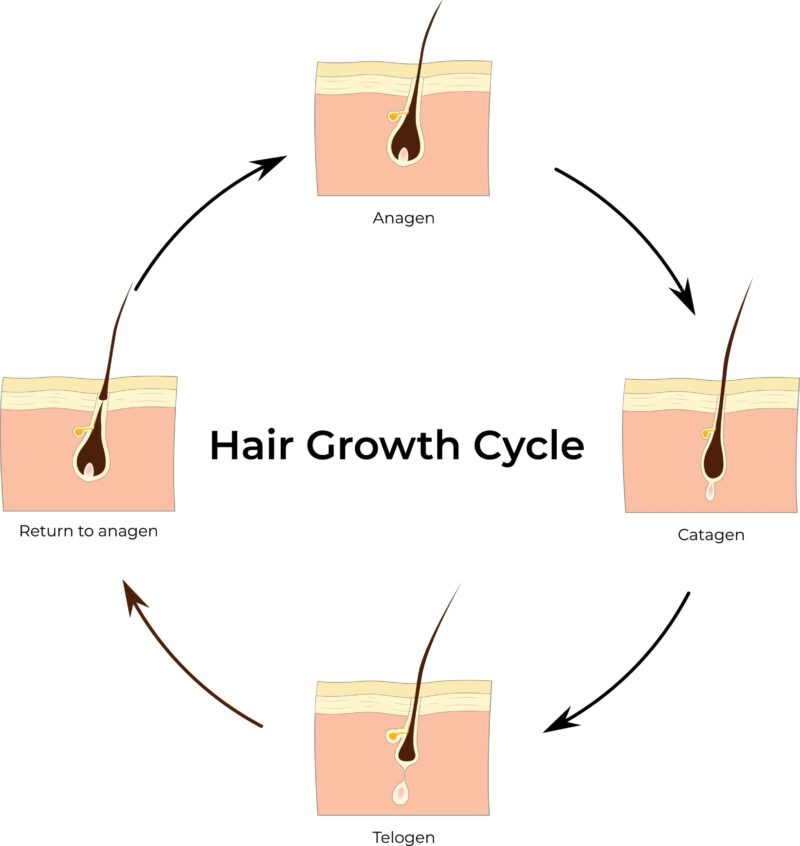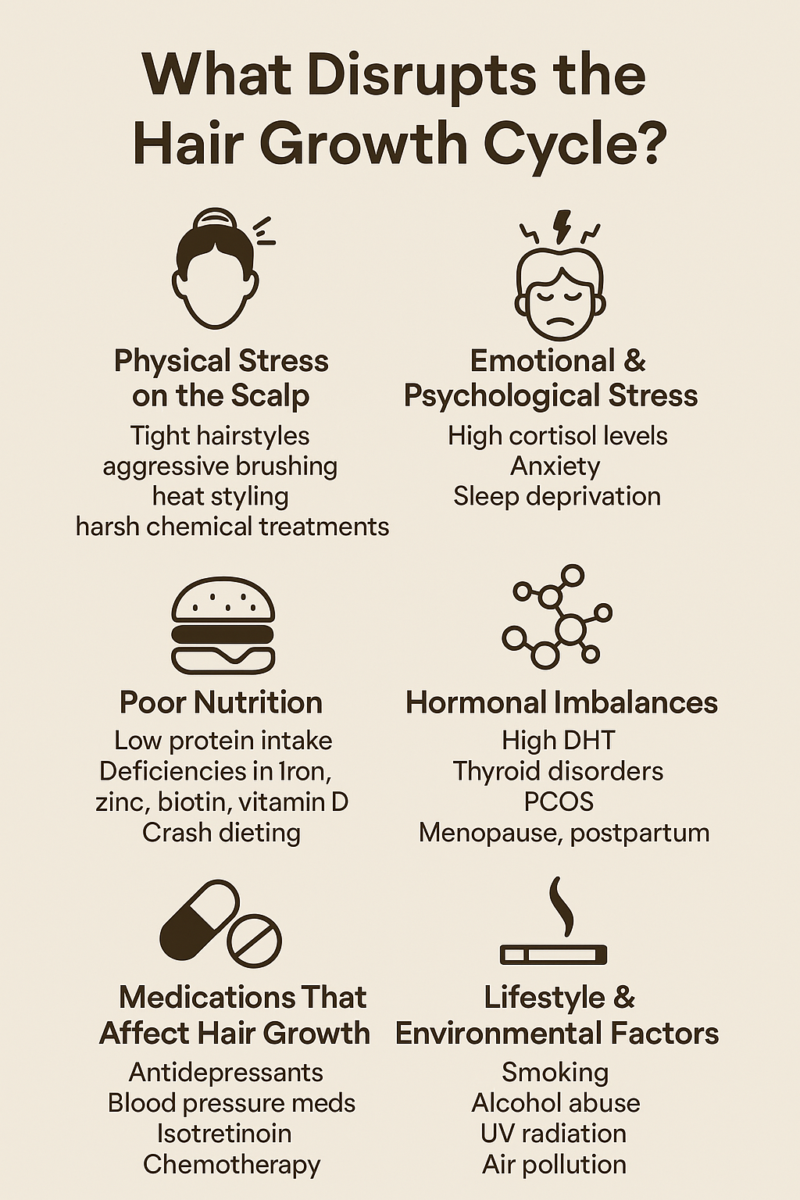Every living creature is born, grows and dies. Hair is no different. Except, it is. The hair growth cycle is a continuous loop of death and resurrection. At least, until hair dies for good.
Depending on the person, the cycle can be longer, shorter, and death may come sooner or later than expected. Good news is, there are ways to keep the grim reaper at bay. Understanding the 4 phases of the hair cycle can help us solve the mysteries of hair loss.
What is the Hair Growth Cycle?
The hair growth cycle is made up of four distinct phases: anagen, catagen, telogen, and exogen. Each hair strand goes through this cycle independently, meaning you’re always shedding some hairs while others are growing.
- Anagen phase: This is the active growth stage. Hair cells divide rapidly, and strands can grow for years.
- Catagen phase: A brief transition where growth stops and the hair follicle begins to shrink.
- Telogen phase: A resting phase. Hair stays in the follicle but doesn’t grow.
- Exogen phase: The shedding phase—hair falls out to make room for new strands.
1. Anagen Phase of Hair Growth: The Active Period
The anagen phase of hair growth is the growth phase—the longest and most important stage in the hair cycle. During this time, the hair follicle is fully alive and active, producing new hair cells through rapid cell division.
How long does the anagen phase last?
The anagen phase typically lasts between 2 and 6 years, but in some cases, it can extend up to 7 or even 10 years. The longer this phase lasts, the longer your hair can grow.
Interestingly, body hair (like eyebrows and arm hair) has a much shorter anagen phase—just 30 to 45 days, which is why it never grows as long as scalp hair.
How to increase the anagen phase of growth?
To increase the anagen phase of hair, focus on stimulating the scalp and nourishing the follicles:
- Scalp massage and microneedling can boost blood flow.
- Use growth-supporting ingredients like minoxidil, caffeine, or peptides.
- Low Level Laser Therapy (LLLT) have shown promise in increasing hair density.
- Maintain a protein-rich diet with iron, biotin, and vitamin D.
- Reduce stress—chronic stress can push hair out of anagen prematurely.
Supporting your scalp health is the key to keeping hair in its growth phase longer.
2. Catagen Phase of Hair Growth: Hair Transforms
The catagen phase is the shortest stage of the hair growth cycle and acts as a transitional phase between growth and rest. Only about 1–3% of your hair is in this phase at any given time.
During catagen, hair growth completely stops. The follicle shrinks and detaches from the blood supply, forming what’s called a club hair. This is essentially a fully formed hair strand no longer getting nutrients, but still anchored in the scalp.
How long does the catagen phase last?
The catagen phase of hair growth lasts around 2 to 3 weeks. It’s a brief but crucial stage that marks the end of active growth and prepares the follicle for rest.
Because it’s so short, most people barely notice it happening. However, if a large number of hairs enter catagen at once (due to stress or illness), it can be a sign of a condition like telogen effluvium, a form of temporary hair shedding.
3. Telogen Phase of Hair Growth: All Activity Stops
The telogen phase is the resting phase of the cycle. In this stage, the follicle is inactive, and the hair remains in place but doesn’t grow. About 10–15% of your hair is in the telogen phase at any moment.
This is also when new hairs begin to form beneath the surface, slowly pushing the old (club) hair upward in preparation for shedding.
How Long Does the Telogen Phase Last?
The telogen phase of hair growth typically lasts 3 to 4 months. However, it can be prolonged by physical or emotional stress, nutritional deficiencies, hormonal imbalances, or illness.
The answer depends on your health and genetics, but if too many hairs stay in telogen for too long, it can lead to diffuse thinning or noticeable hair loss.
4. Exogen Phase: Follicle Death & Shedding
The exogen phase is technically an extension of telogen—this is when the hair actually sheds. Old club hairs fall out as new hairs push through the follicle and begin the next anagen cycle.
It’s normal to lose around 50 to 100 hairs per day during this phase. Anything significantly more may be a sign of hair loss conditions.
How long does the exogen phase last?
The exogen phase of hair growth lasts between 2 to 5 weeks, though it can overlap with both the end of telogen and the start of anagen. During this time, multiple follicles can shed simultaneously.
4-Phase Hair Growth Cycle Diagram
How Long Does the Cycle Take? Hair Growth Cycle Time
The complete hair growth cycle time varies from person to person but generally spans 2 to 7 years.
- The anagen phase lasts 2 to 6 years, depending on genetics and health.
- The catagen phase lasts about 2 to 3 weeks.
- The telogen phase can last around 3 to 4 months.
- The exogen phase overlaps with telogen and lasts a few weeks as the hair sheds.
A longer anagen phase means longer, thicker hair. The good news? There are ways to increase the anagen phase and delay the resting and shedding stages—more on that soon.
Hair Growth Disruptors and Hair Loss
These factors can shorten the anagen phase, trigger premature telogen shedding, and weaken the hair follicle, leading to hair loss or thinning:
🔥 Physical Stress on the Scalp
- Tight hairstyles (ponytails, braids, extensions) → traction alopecia
- Aggressive brushing or frequent heat styling
- Overuse of harsh chemical treatments (bleaching, perms, relaxers)
🧠 Emotional & Psychological Stress
- High cortisol levels from chronic stress can push hair into the telogen phase (telogen effluvium)
- Anxiety and sleep deprivation negatively affect follicle function
🍔 Poor Nutrition
- Low protein intake → hair is made of keratin (a protein)
- Deficiencies in iron, zinc, biotin, vitamin D, B12, omega-3s
- Crash dieting or calorie restriction disrupts follicle energy supply
⚠️ Hormonal Imbalances
- High DHT (dihydrotestosterone) levels shrink follicles → androgenetic alopecia
- Thyroid disorders (hypothyroidism, hyperthyroidism)
- PCOS (Polycystic Ovary Syndrome) in women
- Menopause or postpartum hormonal shifts
💊 Medications That Affect Hair Growth
- Antidepressants (e.g., SSRIs)
- Blood pressure meds (beta blockers, ACE inhibitors)
- Isotretinoin (used for acne)
- Chemotherapy
- Birth control pills (starting or stopping)
🚬 Lifestyle & Environmental Factors
- Smoking reduces blood flow to hair follicles
- Alcohol abuse interferes with nutrient absorption
- UV radiation from sun exposure damages the scalp
- Air pollution and toxins can cause oxidative stress on follicles
🧬 Genetic Conditions & Autoimmune Disorders
- Alopecia areata: the immune system attacks hair follicles
- Lupus and other systemic inflammatory conditions
- Trichotillomania: hair-pulling disorder
How Can I Stimulate Hair Growth?
When the hair growth cycle is disrupted—whether due to stress, hormones, or genetics—there are ways to stimulate regrowth, restore balance, and protect hair follicles. The best approach depends on the cause and severity of the damage.
1. Natural & Lifestyle-Based Solutions
🔹 Nutritional Support
- Prioritize protein, iron, biotin, zinc, omega-3s, and vitamin D.
- Consider supplements if blood tests show deficiencies.
🔹 Stress Reduction
- Mindfulness, better sleep, and reduced screen time can reduce cortisol levels.
- Cortisol is known to push hairs prematurely into the telogen phase.
2. Medical Treatments
These options are ideal for those experiencing progressive hair thinning or hair loss due to genetics, hormones, or chronic inflammation.
🔹 PRP Therapy (Platelet-Rich Plasma)
- Uses your own blood to extract growth factors.
- Injected into the scalp to stimulate dormant follicles.
- Boosts collagen and blood flow to support the anagen phase.
🔹 Stem Cell Treatments
- Extract stem cells (often from fat tissue or scalp biopsies) to regenerate hair follicles.
- Helps reset the cycle in miniaturized or weakened follicles.
- Available at advanced clinics, including Dr. Serkan Aygin Clinic.
🔹 Minoxidil & Finasteride
- Minoxidil: topical treatment to prolong the anagen phase.
- Finasteride: oral medication that blocks DHT, often used in male pattern hair loss.
3. Hair Transplant Solutions
Dr. Serkan Aygin, a world-renowned specialist in Istanbul, offers free online consultations to assess your needs and recommend the best techniques.
🔹 Stem Cell Hair Transplant
- Combines traditional transplant methods with stem cell therapy.
- Promotes faster healing and boosts regrowth in the donor and recipient areas.
🔹 DHI (Direct Hair Implantation)
- Uses a special Choi implanter pen for precise placement of grafts.
- No channel opening required; less trauma and faster recovery.
🔹 FUE Sapphire Technique
- Uses ultra-sharp sapphire blades to open micro-channels.
- Minimally invasive, with natural-looking results and high density.
🔹 Hair Transplant for Women
- Customized to female hair loss patterns (often diffuse thinning).
- Focus on hairline preservation, minimal shaving, and aesthetic balance.
FAQs
How long is a hair growth cycle?
The full hair growth cycle lasts 2 to 7 years, depending on genetics and health. It includes four phases: anagen (growth), catagen (transition), telogen (rest), and exogen (shedding).
How do I restart my hair growth cycle?
You can stimulate a new cycle with scalp massage, PRP therapy, minoxidil, microneedling, and lifestyle changes like better nutrition and stress reduction.
At what age does hair stop growing on your head?
Hair growth slows around age 50, but it doesn’t stop completely. Genetics, hormones, and health determine when growth weakens or stops in certain areas.
What is the best vitamin for hair growth?
Biotin (Vitamin B7) is widely recognized for supporting hair growth, but vitamin D, iron, zinc, and omega-3s are also crucial for healthy follicles.
Will cutting hair help it grow?
Cutting hair doesn’t affect follicle activity but removes split ends, making hair appear healthier and preventing breakage that could limit length.
How can I trigger rapid hair growth?
Combine minoxidil, microneedling, scalp massage, and a high-protein, nutrient-rich diet. Avoid stress and harsh treatments to keep follicles in the anagen phase longer.



